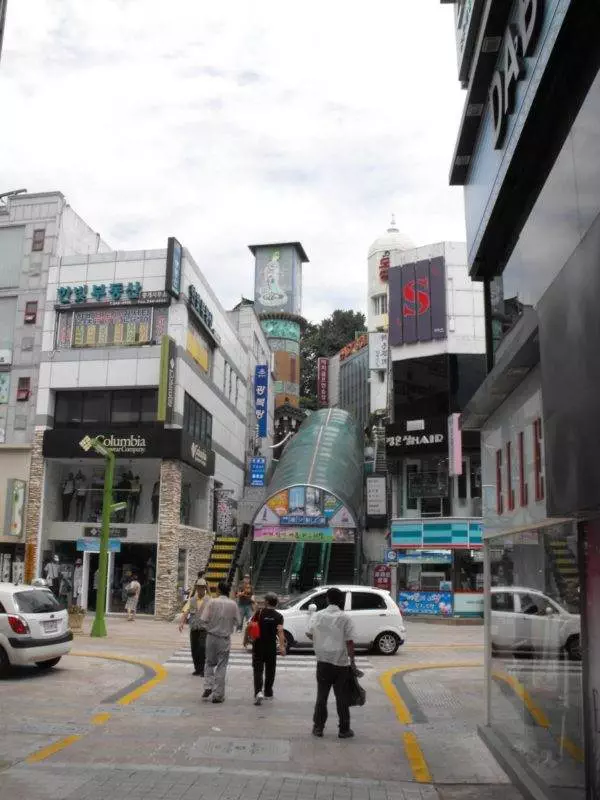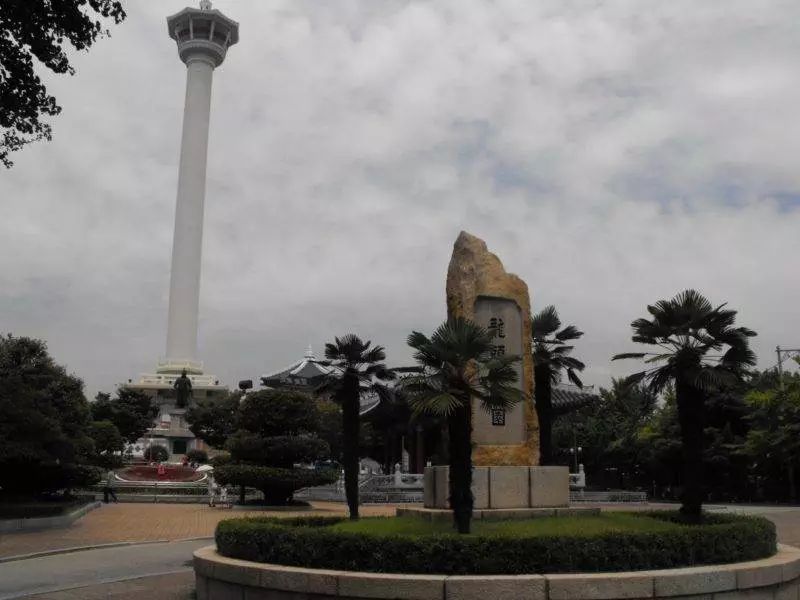The Busan Tower, located inside Yongdusan Park, remains one of the best spots to see the whole city – water and land – in a sweeping 360 degree view. While not as tall as the Seoul Tower, I liked the view from Busan better – and less pollution means less haze. At 120 meters tall (about 394 feet), it’s Busan’s most obvious and well-known landmark. It’s also located inside a full-fledged park (as opposed to Seoul Tower’s amusement-park-like layout – although Yongdu Park is still a fun time, there’s not as much greenspace).

Leading up to Yongdusan Park is a series of 4 covered elevators which makes getting up to the park a lot easier. Getting down, however, requires you to take the stairs – consider yourself warned.

An opening area, with the Busan Tower in the background. Yongdu means ‘the head of a dragon’, since the area is shaped like the head of a dragon coming out from the sea.

A classic flower clock – quite beautiful. This is supposedly the only flower clock with a second hand in Korea.

A wonderful Buddhist bell. Although gates blocked your way into the area, it’s still easy to see from about 10 meters (30 feet) away.

Some modern-looking art at the park.

A statue of Admiral Yi, commemorating his defeat of a large-scale assault by the Japanese in 1592, as well as never losing a naval battle from then until his death in 1597.

Called yongtap, an interesting-looking dragon trying to ascend to heaven, according to the brochure. The picture is a little dark thanks to the overcast day, but the dragon was actually a light gray in color.

A map of the buildings – admission to both the observation deck and the museum was 5,500 won (about $5.50) – the only places to see that weren’t free.

Panoramic of the Busan area – click for a much larger picture!

Panoramic #2 of the Busan area – click for a much larger picture!

The Museum of Musical Instruments of the World – as the only one visiting during a weekday, it was rather nice taking my time to explore the exhibits.

A Tibetian ‘singing bowl’ – the only instrument available to be played in the entire museum. Tap the brass bowl on the thin lip with the wooden stick, then rub the stick against the outer circumference of the bowl tightly, as if cleaning all the frosting from inside a bowl.

A selection of musical instruments from Europe. The big guitar-looking instrument on the right is called a bandura, from the Ukraine.

Instruments from China – a violin-like instrument in the middle is called a aijieke, while a liugin and a pipa are on the right.

On the left, a soung gouk from Myanmar; in the middle, a dingung from Vietnam; on the right, an unnamed stringed instrument that resembles a guitar.
At this point in my self-guided / solo tour, I was told ‘no pictures’ by the lady working the desk. Of course, there’s no sign in English or icons of the ‘no pictures’ variety representing this… I soon climbed up the circular set of stairs in the middle of the building to the second floor, where I saw… more of the same. Exotic Asian, European, African, South American, and Indian instruments, along with many other nationalities.
It truly is a museum of world instruments – except I didn’t see anything from the American sector. Perhaps they’re considered so common that they don’t need to be seen in a museum – your guess is as good as mine. It’s striking to see how many differences there are – and how many similarities. Most instruments – no matter where you are in the world – have the musician strum or pluck a string, beat on a drum, blow into a pipe with holes, and the like. There are a few unique instruments that don’t fit these molds – the Tibetian singing bowl, a bagpipe, etc. – and it’s nice to see some of the diversity available in music.
After exiting the museum and tower area, I walked around the park area a little more. It’s certainly a nice area, albeit small. While not enough here to keep you busy for more than a few hours, it’s certainly a great destination if you’re coming to Busan.
Directions to Yongdusan Park / Busan Tower:
Take the Busan subway’s line 1 to Nampo-dong, then look to the maps inside the subway for directions. It’s about a 10 minute walk to the elevators pictured above. Once you’re at the top of the elevators, you’re there 🙂


